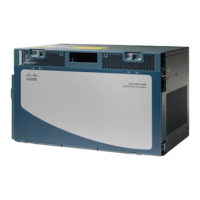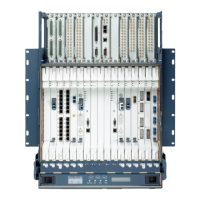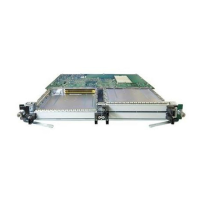2-84
Cisco ONS 15454 Troubleshooting Guide, R8.5
November 2009
Chapter 2 Alarm Troubleshooting
2.7.87 EOC-L
Note If a port in the IS admin state does not receive a signal, the LOS alarm is raised and the port
service state transitions to OOS-AU,FLT.
Step 7 For all nodes, if the card is in service, use an optical test set to determine whether signal failures are
present on fiber terminations. For specific procedures to use the test set equipment, consult the
manufacturer.
Caution Using an optical test set can disrupt service on the OC-N card. It could be necessary to manually switch
traffic carrying circuits over to a protection path. Refer to the “2.9.2 Protection Switching, Lock
Initiation, and Clearing” section on page 2-262 for commonly used switching procedures.
Step 8 If no signal failures exist on terminations, measure power levels to verify that the budget loss is within
the parameters of the receiver. See the “1.12.3 OC-N Card Transmit and Receive Levels” section on
page 1-146 for non-DWDM card levels and refer to the Cisco ONS 15454 DWDM Reference Manual for
DWDM card levels.
Step 9 If budget loss is within parameters, ensure that fiber connectors are securely fastened and properly
terminated. For more information refer to the “Install Cards and Fiber-Optic Cable” chapter in the
Cisco ONS 15454 Procedure Guide.
Step 10 If fiber connectors are properly fastened and terminated, complete the “Reset an Active TCC2/TCC2P
Card and Activate the Standby Card” procedure on page 2-270.
Wait ten minutes to verify that the card you reset completely reboots and becomes the standby card.
Resetting the active TCC2/TCC2P switches control to the standby TCC2/TCC2P. If the alarm clears
when the ONS 15454 node switches to the standby TCC2/TCC2P, the user can assume that the
previously active card is the cause of the alarm.
Step 11 If the TCC2/TCC2P reset does not clear the alarm, delete the problematic SDCC termination:
a. From the View menu in card view, choose Go to Previous View if you have not already done so.
b. Click the Provisioning > Comm Channels > SDCC tabs.
c. Highlight the problematic DCC termination.
d. Click Delete.
e. Click Yes in the Confirmation Dialog box.
Step 12 Recreate the SDCC termination. Refer to the “Turn Up Network” chapter in the Cisco ONS 15454
Procedure Guide for procedures.
Step 13 Verify that both ends of the DCC have been recreated at the optical ports.
Step 14 If the alarm has not cleared, call Cisco TAC 1 800 553-2447. If the Cisco TAC technician tells you to
reseat the card, complete the “Remove and Reinsert (Reseat) the Standby TCC2/TCC2P Card” procedure
on page 2-272. If the Cisco TAC technician tells you to remove the card and reinstall a new one, follow
the “Physically Replace a Traffic Card” procedure on page 2-273.
2.7.87 EOC-L
Default Severity: Minor (MN), Non-Service-Affecting (NSA) for OCN

